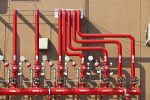Choosing the best nozzle for your fire hose starts with knowing its intended uses. Then, consider the nozzle type and flow rates.
Some metal nozzles are dipped in rubberlike coatings and others have baked-on enamel finishes that add durability and protection against the elements. Plastic nozzles crack when dropped and break down after prolonged sun exposure. Look for nozzles made of metal or metal-and-plastic hybrids instead.
Types
There are many different types of fire hose nozzles that are used by firefighters. Each type has its own advantages and disadvantages. The right choice depends on the needs of the department.
The size of the nozzle’s opening controls the water flow. This in turn affects the water pressure and the nozzle’s reach. The nozzle also creates the shape of the water stream. It can be shaped as a straight jet for penetration or as a fog spray for radiant heat protection.
Some nozzles allow the operator to select a desired gallonage or pattern by turning a dial on the handle. This can be beneficial when fighting wildfires.
Some nozzles are made of metal, while others are made of plastic. They are tested to withstand high and low temperatures, rough handling, and impact resistance. Nozzles must be able to open and close easily, with no more than three pounds of force required for the lever or rotational control to operate.
Flow Rates
A fire nozzle does not create flow. It can only dispense water at a rate that is limited by the available pump capacity and hose lays.
The nozzle’s reaction force also limits its ability to handle higher water pressures. Newton’s Third Law states that for every action, there is an equal and opposite reaction. At 50 psi, a standard smooth-bore nozzle exerts about 68 pounds of pressure against its operator.
Some of today’s fire nozzles offer options for changing the flow rates to accommodate different situations. For example, the Task Force Tips Metro 1 nozzle, for 1-1/2-inch hoselines, allows firefighters to select a fixed gallonage and a fog or stream pattern, which can be changed without shutting down the nozzle. This type of nozzle is often used for structural firefighting and public education, where it’s important that the spray pattern remains constant to keep firefighters safe from the effects of smoke inhalation. This type of nozzle requires higher level training for the firefighter and the pump operator.
Materials
Whether firefighting on the ground or at a command post, firefighters must be able to deploy their primary weapon with ease. This requires a thorough understanding of the nozzle’s operation, maintenance requirements, downfalls, flow rates, reaction forces and special features.
The nozzle must also be lightweight to reduce fatigue and provide more comfort while in use. It should also withstand high water pressures without bursting or failing. NFPA 1964 sets minimum requirements for lever- and rotational-type controls, which must open with at least three pounds of force.
Nozzles are often rated at 50 or 75 psi to reduce the amount of force required to operate them, which may help with human resource limitations. Fluctuations in climatical conditions are surging wildfire incidents, which drive the demand for fire safety systems. Moreover, increasing construction activities for hotels are expected to fuel the market growth.
Installation
Nozzles connect to hoses through threaded couplings or attachment points. The nozzle must have a thread connection of a compatible size and type for proper operation and fit. NFPA 1964 also sets the maximum amount of force required to operate lever-type and rotational controls on fire hose nozzles. Lever-type controls should open with no more than three pounds of pressure, and rotational control handles should be able to rotate with about 40 pounds of force.
The simplest and most inexpensive fire hose nozzles are smooth-bore nozzles. They produce a solid stream and provide the highest reach/gpm combination and lowest engine pump pressures. Depending on the situation, other nozzle types may be preferred. For example, some wildland situations require the heat adsorption and radiant heat protection of a foam system or the wide angle fog spray of a multi-purpose nozzle. Other situations might call for the penetrating power and shape of a straight stream. It’s best to be prepared for a variety of situations by having several different types of fire nozzles in your fleet.nozzle for fire hose
